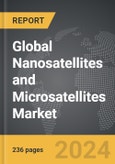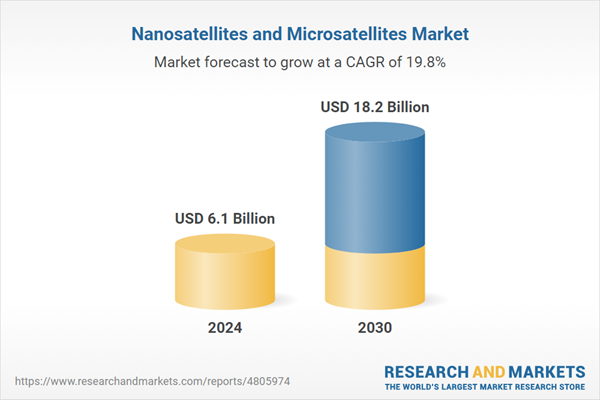The global market for Nanosatellites and Microsatellites was valued at USD 6.1 Billion in 2024 and is projected to reach USD 18.2 Billion by 2030, growing at a CAGR of 19.8% from 2024 to 2030. This comprehensive report provides an in-depth analysis of market trends, drivers, and forecasts, helping you make informed business decisions.
Global Nanosatellites and Microsatellites Market - Key Trends & Drivers Summarized
What Are Nanosatellites and Microsatellites, and How Are They Shaping Space Exploration?
Nanosatellites and microsatellites refer to small-sized satellites, typically weighing between 1 to 10 kilograms (nanosatellites) and 10 to 100 kilograms (microsatellites), used for various space missions. These miniaturized satellites offer cost-effective and flexible alternatives to traditional large satellites, providing services like Earth observation, telecommunications, scientific research, and defense applications. Their smaller size and lower manufacturing costs allow for more frequent launches, often as part of satellite constellations, enabling coverage of large geographical areas or continuous data monitoring. Nanosatellites and microsatellites are increasingly being used by private companies, research institutions, and government agencies to explore space, monitor environmental changes, and enhance global communications infrastructure.How Are Technological Advancements Driving Nanosatellite and Microsatellite Development?
Technological innovations in miniaturization, propulsion systems, and satellite communication are key drivers of growth in the nanosatellite and microsatellite market. Advancements in microelectronics and sensor technologies have significantly increased the functionality of these small satellites without compromising performance. Additionally, improvements in propulsion and attitude control systems have enhanced the maneuverability and longevity of nanosatellites and microsatellites in orbit. The development of high-efficiency solar panels and compact batteries is enabling longer missions, while advancements in artificial intelligence (AI) and machine learning are enhancing the autonomy of these satellites, allowing them to process data and make decisions in real-time. Moreover, the increasing adoption of reusable rockets, pioneered by companies like SpaceX, has reduced the cost of satellite launches, making nanosatellites and microsatellites more accessible to a broader range of users.How Are Commercial and Government Applications Shaping the Demand for Small Satellites?
The demand for nanosatellites and microsatellites is being driven by a diverse range of applications across industries. In the commercial sector, these small satellites are playing a critical role in enhancing global connectivity, particularly for satellite internet services, remote sensing, and telecommunications. Companies like Amazon and SpaceX are deploying large constellations of nanosatellites to provide global internet coverage. In government and defense sectors, nanosatellites are being used for intelligence gathering, Earth observation, and monitoring climate change, enabling real-time data collection at lower costs. Additionally, the rise of space exploration missions conducted by private and public organizations is increasing the need for these small satellites, as they can be launched more frequently and at a fraction of the cost of larger satellites. Universities and research institutions are also leveraging nanosatellites for scientific experiments and space research, further expanding their utility across different sectors.What Are the Key Growth Drivers in the Nanosatellites and Microsatellites Market?
The growth in the nanosatellites and microsatellites market is driven by several factors, including advancements in satellite miniaturization, increasing demand for satellite-based communication services, and the rise of commercial space ventures. Technological innovations in propulsion, power management, and sensor technologies are enabling the development of more powerful and efficient small satellites. The growing need for global connectivity, especially in remote and underserved regions, is fueling demand for satellite-based internet services, pushing companies to deploy nanosatellite constellations. Government initiatives aimed at space exploration, defense, and climate monitoring are also contributing to market growth. Additionally, the reduction in launch costs due to reusable rockets is making it easier for smaller organizations, universities, and startups to access space, leading to more frequent launches of nanosatellites and microsatellites. The rise of private space ventures and the increasing collaboration between governments and private companies are further accelerating the market's expansion.Report Scope
The report analyzes the Nanosatellites and Microsatellites market, presented in terms of market value (USD Thousand). The analysis covers the key segments and geographic regions outlined below.Segments
Type (Nanosatellites, Microsatellites); Application (Remote Sensing / Earth Observation, Communication & Navigation, Scientific Research, Academic & Technology Training); End-Use (Commercial, Defense & Security, Government, Civil).Geographic Regions/Countries
World; United States; Canada; Japan; China; Europe (France; Germany; Italy; United Kingdom; and Rest of Europe); Asia-Pacific; Rest of World.Key Insights:
- Market Growth: Understand the significant growth trajectory of the Nanosatellites segment, which is expected to reach $15.4 Billion by 2030 with a CAGR of a 20.5%. The Microsatellites segment is also set to grow at 16.7% CAGR over the analysis period.
- Regional Analysis: Gain insights into the U.S. market, valued at $1.8 Billion in 2024, and China, forecasted to grow at an impressive 19.3% CAGR to reach $2.8 Billion by 2030. Discover growth trends in other key regions, including Japan, Canada, Germany, and the Asia-Pacific.
Report Features:
- Comprehensive Market Data: Independent analysis of annual sales and market forecasts in USD from 2024 to 2030.
- In-Depth Regional Analysis: Detailed insights into key markets, including the U.S., China, Japan, Canada, Europe, Asia-Pacific, Latin America, Middle East, and Africa.
- Company Profiles: Coverage of major players such as Innovative Solutions In Space, Lockheed Martin Corporation, Planet Labs, Inc., Raytheon Company, RUAG Holding AG and more.
- Complimentary Updates: Receive free report updates for one year to keep you informed of the latest market developments.
Why You Should Buy This Report:
- Detailed Market Analysis: Access a thorough analysis of the Global Nanosatellites and Microsatellites Market, covering all major geographic regions and market segments.
- Competitive Insights: Get an overview of the competitive landscape, including the market presence of major players across different geographies.
- Future Trends and Drivers: Understand the key trends and drivers shaping the future of the Global Nanosatellites and Microsatellites Market.
- Actionable Insights: Benefit from actionable insights that can help you identify new revenue opportunities and make strategic business decisions.
Key Questions Answered:
- How is the Global Nanosatellites and Microsatellites Market expected to evolve by 2030?
- What are the main drivers and restraints affecting the market?
- Which market segments will grow the most over the forecast period?
- How will market shares for different regions and segments change by 2030?
- Who are the leading players in the market, and what are their prospects?
Some of the 26 major companies featured in this Nanosatellites and Microsatellites market report include:
- Innovative Solutions In Space
- Lockheed Martin Corporation
- Planet Labs, Inc.
- Raytheon Company
- RUAG Holding AG
- Sierra Nevada Corporation
- SpaceQuest Ltd.
Table of Contents
I. METHODOLOGYII. EXECUTIVE SUMMARY2. FOCUS ON SELECT PLAYERSIII. MARKET ANALYSISIV. COMPETITION
1. MARKET OVERVIEW
3. MARKET TRENDS & DRIVERS
4. GLOBAL MARKET PERSPECTIVE
UNITED STATES
CANADA
JAPAN
CHINA
EUROPE
FRANCE
GERMANY
ITALY
UNITED KINGDOM
REST OF EUROPE
ASIA-PACIFIC
REST OF WORLD
Companies Mentioned (Partial List)
A selection of companies mentioned in this report includes, but is not limited to:
- Innovative Solutions In Space
- Lockheed Martin Corporation
- Planet Labs, Inc.
- Raytheon Company
- RUAG Holding AG
- Sierra Nevada Corporation
- SpaceQuest Ltd.
Table Information
| Report Attribute | Details |
|---|---|
| No. of Pages | 236 |
| Published | April 2025 |
| Forecast Period | 2024 - 2030 |
| Estimated Market Value ( USD | $ 6.1 Billion |
| Forecasted Market Value ( USD | $ 18.2 Billion |
| Compound Annual Growth Rate | 19.8% |
| Regions Covered | Global |









